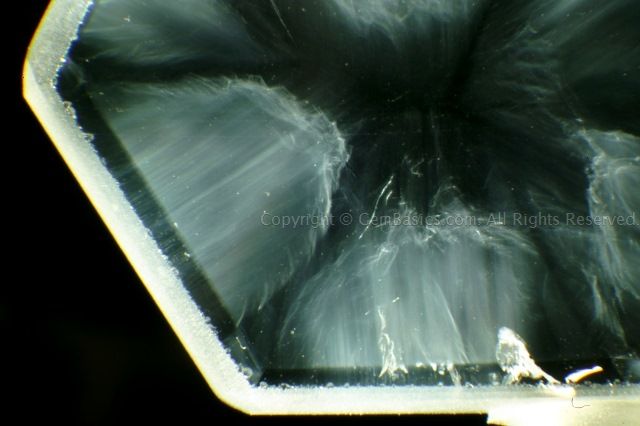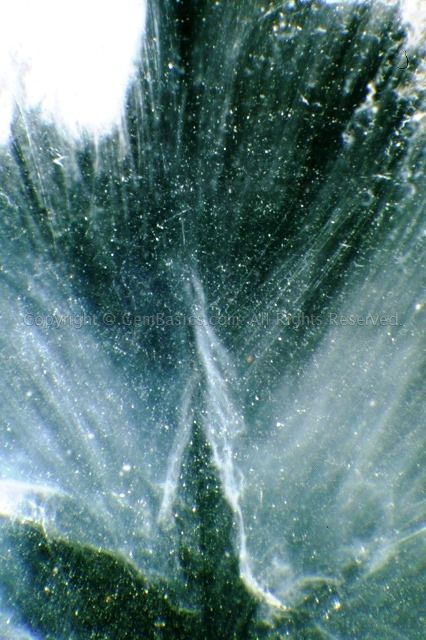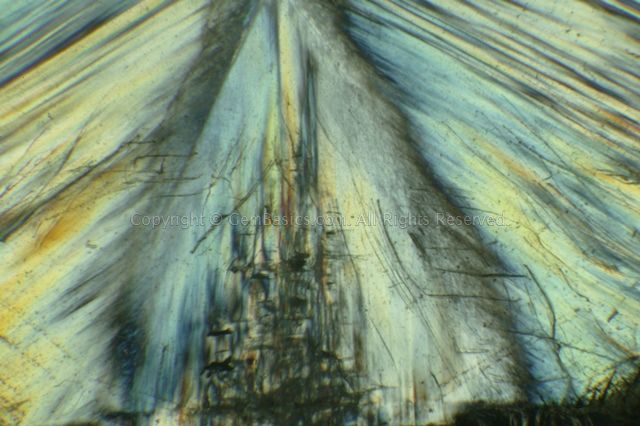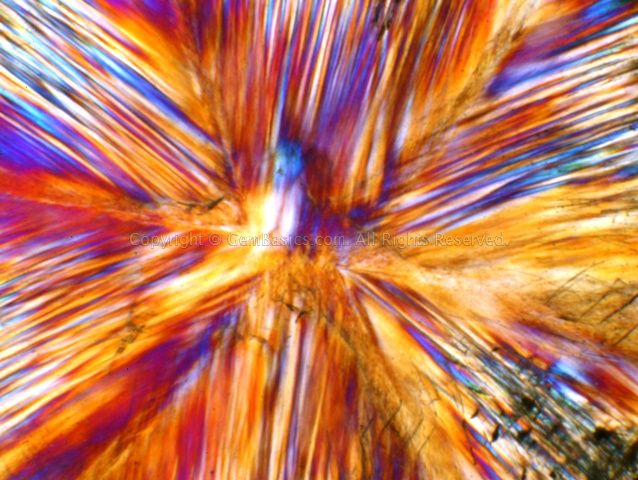www.GemstoneBasics.com
Home > Featured articles > True Trapiche Quartz from Colombia?
First draft: November 20th, 2013 | Last update: April 30th, 2016 | References: 89
True Trapiche Quartz from Colombia?
A New Find from Boyacá and Santander Departments, Colombia.
While visiting a mineral and gem fair in 2013, I came across a well-known Colombian emerald dealer based in Idar-Oberstein, Germany, who was offering sliced and polished quartz crystals (Figure 1). These slices were labelled as "trapiche quartz" and were said to originate from the Boyacá and Santander Departments in Colombia.
The dealer explained that he wasn't sure these stones actually were trapiche, but that he still had acquired the entire parcel because he was intrigued by their appearance (to be true, I would have done the same). He also said that when the slices were observed through the polariscope (Figure 3) they revealed similarities with the pattern of the trapiche emeralds he had in his inventory.
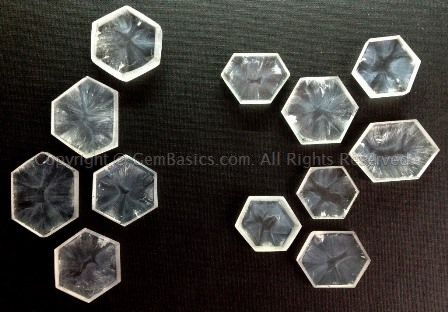
The designation "trapiche" refers to a growth phenomenon that has been defined by the skeletal and sectoral growth of a crystal, yielding a fixed star when observed in sections perpendicular to the c- and optic axis of the crystals (Schmetzer et al., 2011). From a historical point of view, it was first identified in emerald (Bertrand, 1879) and because of its resemblance of the spoke wheel once used to crush cane sugar, it was baptised "trapiche" (McKague, 1964).
After its discovery in emerald in 1879 trapiche has been studied intensively to explain the growth process responsible for the structure (Bernauer, 1926; McKague, 1964; Leiper, 1967; Schiffmann, 1968; Chaudhari, 1969; Nassau & Jackson, 1970; Tripp & Hernandez, 1970; O'Donoghue, 1971; Nassau, 1978; Sinkankas, 1981; Themelis, 1987; DelRe, 1994; Overton, 2005).
For long the phenomenon was thought to occur solely in emerald, but it also occurs in the chiastolite variety of andalusite. Then came the discovery of trapiche rubies in Mong Hsu in Myanmar (Burma) (Müllenmeister & Zang, 1995; Henn & Bank, 1996; Schmetzer, et al., 1996; Schmetzer et al., 1998; Sunagawa et al., 1999; Garnier et al., 2002; Win, 2005).
Trapiche sapphires followed quite soon (Koivula et al., 1994; Beaton, 2008; Kotchanin et al., 2009; Kiefert, 2012), to be followed by beryl not long after that (Koivula, 2008). However, a similar phenomenon involving unequal growth rates of beryl crystals seems to have been described earlier on (Sahama, 1966). Cordierite may display the phenomenon as well (Rakovan et al., 2006; Rakovan, 2007).
Recently, trapiche tourmaline originating from Zambia (Hainschwang et al., 2007; Schmetzer et al., 2011) was added to this list. Not much later, a "trapiche garnet" was shown to the world on GemologyOnline.com, clearly showing the characteristic pattern.
And also trapiche quartz is found. According to Mindat.org, it is rare and has been found in the Dorogawa-Goyomatsu mine, Honshu Island, Japan. No slices of this material are known so far. Recently, some cabochons appeared on the market which were said to originate from the Mogok Stone Tract in Myanmar (Burma). Some very odd slices were also produced from a find in Canada.

The structure observed in the crystal slices acquired, that is, a fixed star separating different sectors, does show analogies with other trapiche gems but the phenomenon only becomes fully apparent when the slices are examined through the polariscope (Figure 3). The core and arms seem to be very clean which is the absolute contrary of trapiche growth known so far in the mineral and gem world.
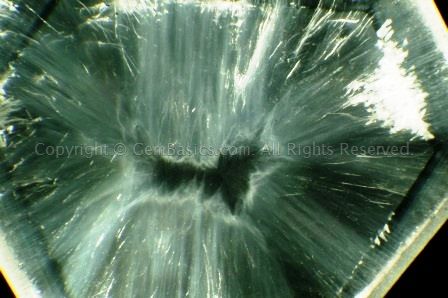
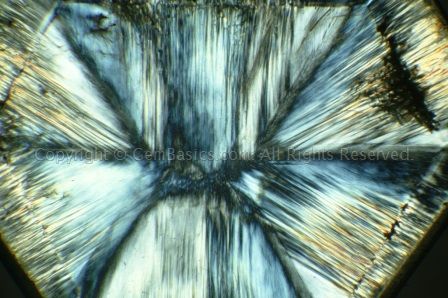
Three phenomena seem to appear together in this material: (1) sector zoning following the negative and positive rhombohedron and probably also following the prism, (2) Brazil law twinning in each of the sectors, and (3) different concentrations of thread- or fiber-like inclusions in each of the sectors instead (Schmetzer, Hyrsl, 2015). However, in trapiche gems, inclusions define the fixed star and in this case clear zones ensure contrast.
Due to this feature which does not correspond with the earlier definition as issued by Win (2005), and later refinements made by Schmetzer et al. (2011) concerning symmetry, colour-zoning, and inclusions, the reverse situation of the fibrous inclusions being present in the sectors and slightly overlapping some rather than in the separations between them, suggests that the crystals grew in a completely different manner.
Krzemincki & Laurs (2014) examined and described the material and state that "[this] phenomenon is not the result of growth dynamics responsible for the trapiche pattern". Therefore the designation trapiche is not appropriate. As recent as April 2016, Jaroslav Hyrsl showed me slices of exactly the same material but originating from Dalnegorsk in Russia's Far East.
Photomicrographs

A general impression of one of the slices and its striking characteristics
6x (FoV ± 25mm) DF, Obl, Pol
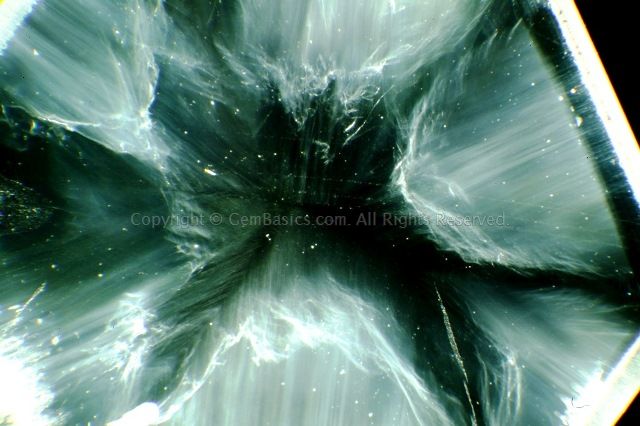
Clear areas overlap the boundaries between growth sectors - the opposite pattern observed in "real" trapiche gems
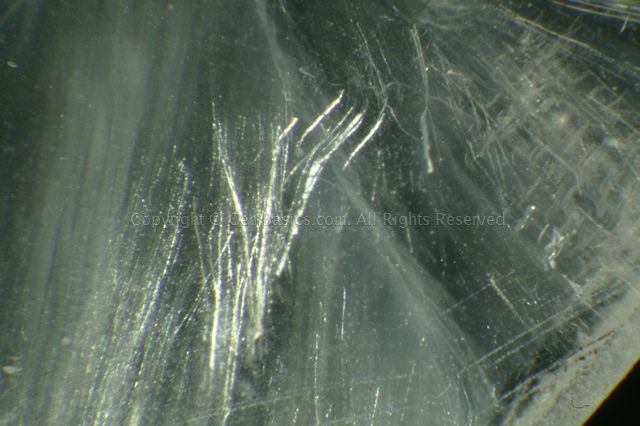
Detail of the thread-like inclusions observed in the cores of the sectors
18x (FoV ± 3mm) Obl, Pol
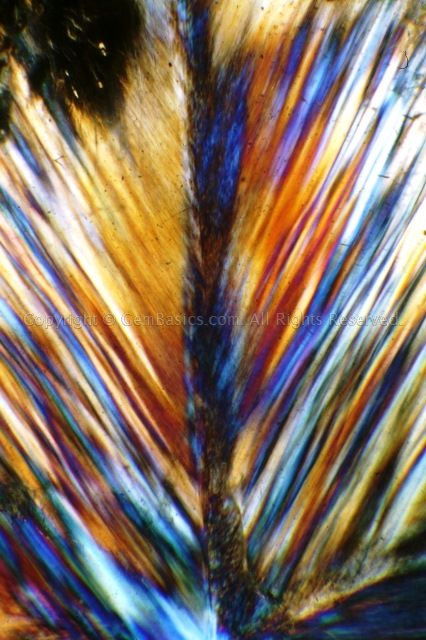
Twinning highlighted by interference colours in the section shown on the left
9x (FoV ± 6mm) X-Pol

Airy's Spiral observed through the conoscope clearly demonstrates Brazil Law twinning in one of this slice's growth sectors
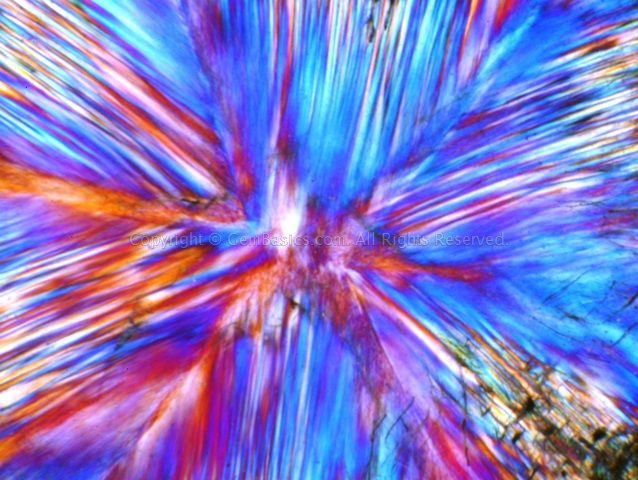
Higher-order interference colours are observed when the section is tilted
6x X-Pol
References and items of related interest
Barry, T.I., McNamara, P. & Moore, J.P. (1965). Paramagnetic resonance and optical properties of amethyst. Journal of Chemical Physics, Vol. 45, pp. 2599-2606. abstract
Beaton, D. (2008). Lab Notes: A rare yellow trapiche sapphire. Gems & Gemology, Vol. 44, No. 3 (Fall), pp. 259-260.
Befi, R. (2011). Trapiche Emerald Imitations. Gems & Gemology, Vol. 13, Issue 2 (February), pp. xxx-xxx.
Bentley, W.A. & Humphries, W.J. (1962). Snow Crystals. Dover Publications, New York, 226 p.
www.SnowCrystals.com
www.its.caltech.edu/~atomic/book/snowflake.htm
Alexey Kljatov's technique
Bernauer, F. (1926). Die sogenannten Smaragddrillinge von Muzo und ihre optischen Anomalien. Neues Jahrbuch für Mineralogie, Geologie und Palaontologie, Supplemental Vol. 54, Part A, pp. 205-242 (in German).
Bertrand, E. (1879). Compte-rendu de la séance du 13 Février 1879. Bulletin de la Société Française de Minéralogie et Crystallographie, Vol. 2, p. 31 (in French).
Buerger, M.J. (1945). The Genesis of Twin Crystals. American Mineralogist, Vol. 30, Nos. 7-8, pp. 469-482. American Mineralogist Tables of Contents
Buerger, M.J. (1954). The stuffed derivatives of the silica structures. American Mineralogist, Vol. 39, pp. 600-614. American Mineralogist Tables of Contents
Carr, J.R. (2010). Andalusite var. Chiastolite. Blue Wing Mountains, Pershing County, Nevada, USA. Axis, Vol. 6, No. 1, pp. xxx-xxx. Also published on The Mineralogical Record
Chaudhari, M.W. (1969). An unusual emerald. Schweizerische mineralogische und petrographische Mitteilungen, Vol. 49, pp. 569-575.
Codazzi, R.L. (1915). Contribucion al Estudio de los Minerales de Colombia. Imprenta de la Cruzada, Bogota, 7 p. (in Spanish)
Cohen, A.J. (1960). Substitutional and interstitial aluminum impurity in quartz, structure and color center interrelationships. Journal of Physics and Chemistry of Solids, Vol. 13, Issues 3-4, pp. 321-325. abstract
DelRe, N. (1994). Gem trade lab notes: Emerald, trapiche from a new locality. Gems & Gemology, Vol. 30, No. 2, pp. 116-117.
Dowty, E. (1976). Crystal structure and crystal growth: II. Sector zoning in minerals. American Mineralogist, Vol. 61, pp. 460-469. American Mineralogist Tables of Contents
Frondel, C. (1934). Origin of the segmental coloration of amethyst and smoky quartz. American Museum Novitates, Vol. 758, pp. 1-15.
Frondel, C., Newhouse, W.H. & Jarrell, R.F. (1942). Spatial distribution of minor elements in single-crystals. American Mineralogist, Vol. 27, pp. 726-745. American Mineralogist Tables of Contents
Garnier, V., Ohnenstetter, D., Giuliani, G. & Schwarz, D. (2002). Rubis trapiches de Mong Hsu, Myanmar. Revue de Gemmologie, Association Française de Gemmologie, No. 144, pp. 5–12.
Garnier, V., Ohnenstetter, D., Giuliani, G., blanc, P. & Schwarz, D. (2002). Trace-element contents and cathodoluminescence of “trapiche” rubies from Mong Hsu, Myanmar (Burma): geological significance. Mineralogy & Petrology, Vol. 76, Issue 3-4, pp. 179-193. abstract
Goette, T. (2008). Cathodoluminescence of authigenic quartz: A fingerprint of crystallisation dynamics? 33rd International Geological Congress Oslo 2008, August 6-14th. abstract
Hainschwang, T., Notari, F. & Anckar, B. (2007). Trapiche Tourmaline from Zambia. Gems & Gemology, Vol. 43, No. 1 (Spring), pp. 36-46.
Hall, R.N. (1953). Segregation of impurities during the growth of germanium and silicon crystals. Journal of Physical Chemistry, Vol. 57, pp. 836-839. excerpt
Henn, U. & Bank, H. (1996). Trapicheartige Korunde aus Myanmar. Gemmologie. Zeitschrift der Deutschen Gemmologischen Gesellschaft, Vol. 45, No. 1, pp. 23-24 (in German).
Hollister, L.S. (1970). Origin, mechanism, and consequences of compositional sector-zoning in staurolite. American Mineralogist, Vol. 55, pp. 742-766. American Mineralogist Tables of Contents
Hollister, L.S. & Bence, A.E. (1967). Staurolite, sectoral compositional variations, Science, 158, pp. 1053-1056. abstract
Hollister, L.S. & Gancarz, A.J. (1971). Compositional sector-zoning in clinopyroxene from the Narce area, ltaly. American Mineralogist, Vol. 56, pp. 959-979. American Mineralogist Tables of Contents
Hsu, T. (2013). Gem News International: Rare Double-Trapiche Emerald. Gems & Gemology, Vol. 49, Issue 1 (Spring), pp. xxx-xxx.
Hyrsl, J. (2015). Personal communication.
Jourdan, A.-L., Vennemann, T.W. & Mullis, J. (2005). Trace element and oxygen isotope zonations in growth sectors of natural quartz crystals. Geochimica et Cosmochimica Acta Supplement, Vol. 69, Issue 10, Supplement 1, Goldschmidt Conference Abstracts 2005, p. A862. abstract
Jourdan, A.-L., Vennemann, T.W., Mullis, J. & Ramseyer, K. (2008). Face-related differential Partitioning of Oxygen Isotopes in low Temperature Quartz. Oral presentation, European Geosciences Union 2008, Vienna (Austria). abstract
Jourdan, A.-L., Vennemann, T.W., Mullis, J. & Ramseyer, K. (2008). What can we learn from parallel studies of trace element and oxygen isotope zoning in quartz? 33rd International Geological Congress Oslo 2008, August 6-14th. abstract
Jourdan, A.-L., Vennemann, T.W., Mullis, J. & Ramseyer, K. (2009). Oxygen isotope sector zoning in natural hydrothermal quartz. Mineralogical Magazine, Vol. 73, No. 4, pp. 615-632. abstract
Jourdan, A.-L., Vennemann, T.W., Mullis, J., Ramseyer, K. & Spiers, C.J. (2007). Trace element distributions in hydrothermal quartz: fluid or structural control? Geochimica et Cosmochimica Acta, Vol. 71, No. 15, pp. A451-A451. abstract
Jourdan, A.-L., Vennemann, T.W., Mullis, J., Ramseyer, K. & Spiers, C.J. (2009). Evidence of growth and sector zoning in hydrothermal quartz from Alpine veins. European Journal of Mineralogy, Vol. 21, No. 1, pp. 219-231. abstract
Khotchanin, K., Thanasuthipitak, K. & Thanasuthipitak, T. (2009). The structure and chemical composition of trapiche blue sapphire from Southern Vietnam and Cambodia. Journal of the Gemmological Association of Hong Kong, Vol. 30, pp. 25–35.
Kiefert, L. (2012). Gem News International: Unusual trapiche sapphire. Gems & Gemology, Vol. 49, No. 3 (Fall), p. 229.
Kitamura, M. & Yamada, H. (1987). Origin of sector trilling in cordierite in Daimonji hornfels, Kyoto, Japan. Contributions to Mineralogy and Petrology, Vol. 97, Issue 1 (September), pp. 1–6. abstract
Koivula, J.I. (2008). Gem News International: Two unusual aquamarines. Gems & Gemology, Vol. 44, No. 3 (Fall), pp. 275-276.
Koivula, J.I., Kammerling, R.C. & Fritsch, E. (1994). Gem news: "Trapiche" purple-pink sapphire. Gems & Gemology, Vol. 30, No. 3 (Fall), p. 197.
Kraft, R.W. (1963). The structure of the Mg-Mg2Sn eutectic. Transactions of the Metallurgic Society, American Institute of Mining, Metallurgical, and Petroleum Engineers (AIME), Vol. 227, No. 2, pp. 393-399.
Krzemincki, M.S. & Laurs, B.M. (2014). Quartz with radiating fibers, sold as 'trapiche quartz'. The Journal of Gemmology, Vol. 34, No. 4, pp. 296-298.
Kyaw Soe Moe (2011). Gem News International: Trapiche spinel from Mogok, Myanmar. Gems & Gemology, Vol. 47, No. 4 (Winter), pp. 329-330.
Leiper, H. (1967). Rare trapiche emerald crystals show unique twinning evidence. The Lapidary Journal, Vol. 21, p. 565.
Leung, I.S. (1974). Sector zoned titanaugites: morphology, crystal chemistry and growth. American Mineralogist, Vol. 59, pp. 127-138. American Mineralogist Tables of Contents
Libbrecht, K.G. (2005). The physics of snow crystals. Reports on progress in physics, Vol. 68, Issue 4 (April), pp. 855-895.
Libbrecht, K. & Rasmussen, P. (2003). The Snowflake: Winter’s Secret Beauty. Voyageur Press, Stillwater, Minnesota, USA 115 p. ISBN 978-0-89658-630-7. www.its.caltech.edu/~atomic/book/snowflake.htm www.SnowCrystals.com
Liebmann, W.K. & Miller, E.A. (1963). Preparation, phase-boundary energies, and thermoelectric properties of InSb eutectic alloys with ordered microstructures. Journal of Applied Physics, Vol. 34, No. 9, pp. 2653-2659. abstract
McKague, H.L. (1964). Trapiche emeralds from Colombia. Gems & Gemology, Vol. 11, No. 7 (Fall), pp. 210-213, 223.
Müllenmeister, H.-J. & Zang, J. (1995). Ein Trapiche-Rubin aus Myanmar (Burma). Lapis, Vol. 20, No. 12, p. 50.
Muller, A. & Williamson, B.J. (2008). Cathodoluminescent quartz textures in transitional magmatic-hydrothermal systems. 33rd International Geological Congress Oslo 2008, August 6-14th. abstract
Müller, A. & Wilhelm, M. (1964). On periodic changes of temperature in liquid InSb causing stratified inclusions of Te in crystallizing TnSb. Zeitschrift für Naturforschung, A, Vol. 19, p. 254.
Muñoz, G. Otero (1948). Esmeraldas de Colombia. Bank of the Republic of Colombia, Bogota, Colombia, 133 p. (in Spanish).
Nakamura, Y. (1973). Origin of sector-zoning of igneous clinopyroxenes. American Mineralogist, Vol. 58, pp. 986-990. American Mineralogist Tables of Contents
Nanev, C.N. (1994). Instability of Faceted Crystal Shapes and their Transformation into Skeletons during Growth under Diffusion Control. Crystallography Reviews, Vol. 4, Issue 1, pp. 3-71. abstract
Nanev, C.N. (1997). Polyhedral instability — skeletal and dendritic growth. Progress in Crystal Growth and Characterization of Materials, Vol. 35, Issue 1, pp. 1–26. abstract
Nassau, K. (1978). Wie Mahlwerke für Zuckerrohr: Trapiche Smaragde von Muzo / Kolumbien. Lapis, Vol. 3, No. 4, pp. 20-23 (in German).
Nassau, K. & Jackson, K.A. (1970). Trapiche Emeralds from Chivor and Muzo, Colombia. American Mineralogist, Vol.55 (March-April), pp. 416-427. American Mineralogist Tables of Contents
Nassau, K. & Jackson, K.A. (1970). Trapiche Emeralds from Colombia: Correction. American Mineralogist, Vol. 55 (September-October), pp. 1808-1809. American Mineralogist Tables of Contents
Nassau, K. & Jackson, K.A. (1970). Trapiche Emeralds from Chivor and Muzo, Colombia: nature and origin. The Lapidary Journal, Vol. 24, p. 82, pp. 84-86.
O'Donoghue, M.J. (1971). Trapiche emerald. The Journal of Gemmology, Vol. 12, No. 8, pp. 329-332.
Ohnenstetter, D., Garnier, V., Giuliani, G. & blanc, P. (2003). Trapiche texture in precious gemstones, Université Pierre et Marie Curie (presentation).
Onasch, C.M. & Vennemann, T.W. (1995). Disequilibrium partitioning of oxygen isotopes associated with sector zoning in quartz. Geology, Vol. 23, No. 12, pp. 1103-1106. abstract
Overton, T.W. (2005). Gem News International: Unusual trapiche emerald earrings. Gems & Gemology, Vol. 41, No. 4 (Winter), p. 352.
Peretti, A., Mullis, J. & Mouawad, F. (1996). The role of fluorine in the formation of colour-zoning in rubies from Mong Hsu, Myanmar (Burma). The Journal of Gemmology, Vol. 25, No. 1, pp. 3-19.
Peretti, A., Schmetzer, K., Bernhardt, H.-J. & Mouawad, F. (1995). Rubies from Mong-Hsu. Gems & Gemology, Vol. 31, No. 1 (Spring), pp. 2-26.
Petreus I. (1974). The divided structure of crystals, II. Secondary structures and habits. Neues Jahrbuch für Mineralogie, Abhandlungen, Vol. 122, No. 3, pp. 314-338.
Petreus, I. (1978). The divided structure of crystals I. Lineage and sectoral structure in pyrite and beryl. American Mineralogist, Vol. 63, pp. 725-731. American Mineralogist Tables of Contents
Pignatelli, I., Giuliani, G., Ohnenstetter, D., Agrosì, G., Mathieu, S., Morlot, C. & Branquet, Y. (2015). Colombian Trapiche Emeralds: Recent Advances in Understanding Their Formation. Gems & Gemology, Vol. 51, No. 3 (Fall), pp. 222-259.
Pogue, J.E. (1916). The emerald in Spanish America. Bulletin of the Pan-American Union, Washington, D.C., Vol. 42, pp. 706-720.
Pogue, J.E. (1916). The emerald deposits of Muzo, Colombia. Transactions of the American Institute of Mining and Metallurgical Engineers, Vol. 55, pp. 910-934.
Poty, B. (1969).
La croissance des cristaux de quartz dans les filons sur l'exemple du filon de La Gardette (Bourg d'Oisans) et des filons du massif du Mont-blanc.
Science de la Terre, Memoire No. 17 (in French).
Rakovan, J. (2007).
"Sakura Ishi" from Kameoka, Japan: Mica pseudomorphs of complex cordierite-indialite intergrowths. New Mexico Mineral Symposium, November 10-11.
abstract
Rakovan, J., Kitamura, M. & Tamada, O. (2006).
Mica Pseudomorphs of Complex Cordierite-Indialite Intergrowths from Kameoka, Kyoto Prefecture, Japan.
Rocks & Minerals, Vol. 81, No. 4 (July/August), pp. 284-292.
Ringsrud, R. (2008).
Collecting Mineral Specimens and Other Rarities: Trapiche Emerald In: Emeralds A passionate Guide - The Emeralds, The People, Their Secrets, pp. 344-346. Greenview Press, Oxnard, CA, USA, 382 p. ISBN 978-0-9822627-5-7.
www.emeraldmine.com
Sahama, T.G. (1966).
Polygonal growth of beryl. Bulletin de la Commission Geologique de Finlande, Vol 222, No. 38, pp. 31-41.
abstract
Schiffmann, C.A. (1968). Unusual emeralds. The Journal of Gemmology, Vol. 11, pp. 105-114.
Schmetzer, K., Hänni, H.A., Bernhardt, H.-J. & Schwarz, D. (1996).
Trapiche rubies. Gems & Gemology, Vol. 32, No. 4, pp. 242-250.
Schmetzer, K., Hänni, H.A., Bernhardt, H.-J. & Schwarz, D. (1997).
Trapiche-Rubine. Deutsche Goldschmiede Zeitung, Vol. 95, pp. 107-112.
Schmetzer, K., Beili, Z., Yan, G. & Bernhardt, H.-J. (1998).
Element mapping of trapiche rubies. The Journal of Gemmology, Vol. 26, No. 5, pp. 289-301.
Schmetzer, K., Bernhardt, H.-J. & Hainschwang, T. (2011).
Chemical and growth zoning in trapiche tourmaline from Zambia – a re-evaluation. The Journal of Gemmology, Vol. 32, No. 5-8, pp. 151-173.
abstract
Sinkankas, J. (1981).
Trapiche emeralds In: Emerald and other beryls, pp. 262-264, Chilton Book Company, Radnor, Pennsylvania & Nelson Canada Limited, Scarborough, Ontario, 665 p. ISBN 0-8019-7114-4.
Skalwold, E.A. & Koivula, J.I. (2015).
Pezzottaite Debuts as the Newest Trapiche Gem Mineral.
Gems & Gemology, Vol. 51, No. 3 (Fall), pp. 326–328.
Schmetzer, K. (2015). Personal communication.
Smith, V.G., Tiller, W.A. & Rutter, J.W. (1955).
A mathematical analysis of solute redistribution during solidification. Canadian Journal of Physics, Vol. 33, p. 723.
abstract
Sunagawa, I. (1999).
Growth and Morphology of Crystals. Forma, Vol. 14, pp. 147-166.
Sunagawa, I. (2003).
Growth Histories of Mineral Crystals as Seen from Their Morphological Features. In: Byrappa, K. & Ohachi, T. (Eds.) Crystal Growth Technology.
Springer Series in Materials Processing, Jointly published with William Andrew Inc., Norwich, NY, USA, 590 p. ISBN 9780471490593.
Sunagawa, I. (2010).
Single Crystals Grown Under Unconstrained Conditions. In: Dhanaraj, G., Byrappa, K. Prasad, V. & Dudley, M. (Eds.) Springer Handbook of Crystal Growth, pp. 133-157, Springer, 1856 p. ISBN: 978-3-540-74182-4 (Print); 978-3-540-74761-1 (Online).
abstract
Sunagawa, I. (2005). Crystals - Growth, Morphology and Perfection. Cambrigde University Press, Cambridge, UK, 295 p. ISBN 978-0-521-84189-4.
excerpt
Sunagawa, I., Bernhardt, H.-J. & Schmetzer, K. (1999).
Texture formation and element partitioning in trapiche ruby. Journal of Crystal Growth, Vol. 206, pp. 322-330.
abstract
Themelis, T. (1987). Trapiche emerald. The Lapidary Journal, Vol. 41, p. 19.
Tiller, W.A., Jackson, K.A., Rutter, J.W. & Chalmers, B. (1953).
The redistribution of solute atoms during the solidification of metals. Acta Metallurgica, Vol. 1, p. 428.
abstract
Tripp, E.J. & Hernandez, L.H. (1970).
The complete trapiche emerald picture. The Lapidary Journal, Vol. 24, p. 97.
Wass, S.Y. (1973).
The origin and petrogenetic significance of hour-glass zoning in titaniferous clinopyroxenes. Mineralogical Magazine, Vol. 39, pp. 133-144.
abstract
Wathanakul, P., Atichat, W., Pisutha-Arnond, V., Win, T.T. & Singbamroong, S. (2004).
Evidence of the Unusually High Be, Sn, Nb, and Ta Content in Some Trapiche-like Sapphires from Basaltic Origins.
Proceedings 29th IGC, Wuhan, China, pp. 114-118.
Win, K.K. (2005). Trapiche of Myanmar. The Australian Gemmologist, Vol. 22, No. 6 (April-June), pp. 269-270.
Wood, D.L. & Nassau, K. (1968).
The characterization of beryl and emerald by visible and infrared absorption spectroscopy. American Mineralogist, Vol. 54, pp. 777-1800.
American Mineralogist Tables of Contents
